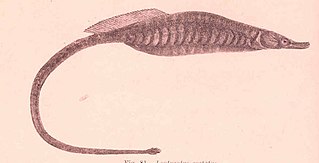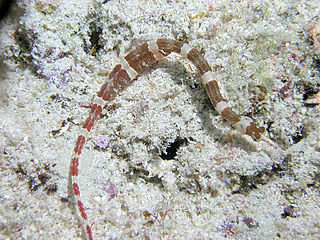This glossary of ichthyology is a list of definitions of terms and concepts used in ichthyology, the study of fishes.

Stigmatopora is a genus of pipefishes native to the Indian and Pacific Oceans.
Duncker's pipehorse, also known as the nose-ridge pipefish, red-and-gold pipehorse, red-hair pipefish or spiny sea dragon, is a species of fish in the family Syngnathidae. It is endemic to eastern Australia and Lord Howe Island. It is a pelagic species which is found in the waters of the continental shelf and the continental slope. Fishermen within its range report that it is caught where there are hard substrates such as hard sand, shale, sandstone or gravel and they are often caught alongside gorgonians, black corals, algae or sponges. It is an ovoviviparous species in which the male bears the fertilised eggs in a brood pouch located under his tail. It is a carnivorous species which feeds on small planktonic crustacean.
Microphis lineatus, the opossum pipefish, is a species of fish in the family Syngnathidae. It is found in fresh, brackish and marine waters in the West Atlantic region, ranging from New Jersey, United States, to São Paulo, Brazil, including the Caribbean and Gulf of Mexico. It is often found in rivers, among water hyacinth roots, in mangrove and in Sargassum.

Pomacanthus navarchus, the blue-girdled angelfish or majestic angelfish, is a marine angelfish from the Indo-Pacific region. It occasionally makes its way into the aquarium trade. P. navarchus is one of the smallest of the larger species of angelfish. It grows to a maximum length of 28 centimetres (11 in), but is usually much smaller than this, and can live to be up to 21 years old. Younger fish stay closer to the shallows, but the more mature fish can be found up to 120 feet (37 m) deep. Majestic angelfish eat mainly sponges and tunicates. Juvenile fish are mostly blue in color with white stripes. As they mature, they take on a yellow coloration on the flanks, dorsal fin, and tail.
The chain pipefish is a pipefish species. It inhabits the western Atlantic from Virginia, Bermuda and northern Gulf of Mexico to Campeche and Jamaica, but is absent from the Bahamas. It is a marine subtropical reef-associated fish, up to 38 cm length.

The Gulf pipefish is a species of pipefish in the member of the taxonomic family Sygnathidae. Syngnathus scovelli is native to the region of south Florida, United States, the Atlantic Ocean, etc. S. scovelli is similar to the species Opossum pipefish also known by its scientific name as Microphisbrachyurus.

The snake pipefish is a species of pipefish, from the family Syngnathidae, native to the northeastern Atlantic Ocean where they are generally found amongst algae close in to shore. It is the largest species of pipefish recorded in European waters and has spread into arctic waters in the early 2000s.

The deepbody pipefish is a species of pipefish endemic to Australia where it is only found along the southern coast. This species grows to a length of 12.9 centimetres (5.1 in) SL. This species is the only known member of the monotypic genus Kaupus which is named in honour of the ichthyologist Johann Jakob Kaup (1803-1873).
Ichthyophis moustakius, the Manipur moustached caecilian, is a species of caecilian in the family Ichthyophiidae. It is endemic to Northeast India. This species exhibits broad lateral yellow stripes from the anterior part of its tail, along its mandibles, between its nares, as well as elsewhere. The animal can reach a length of 300 millimetres (12 in). Its head is somewhat U-shaped and fairly short; scales are absent on its collars. The species' name is derived from the Greek word moustakius, meaning "moustache", due to the yellow arched stripes it possesses.

Corythoichthys amplexus, known commonly as the brown-banded pipefish, is a species of marine fish in the family Syngnathidae.

Pelvicachromis sacrimontis is a freshwater fish of the cichlid family known only from a small area of southeastern Nigeria. Currently Fishbase considers this binomial to be a junior synonym of P. pulcher and, it was also known as Pelvicachromis camerunensis, P. pulcher "form B" or P. sp. aff. pulcher but some authorities now consider it to be a valid species. It is occasionally available in the tropical fish trade as "giant krib" and there are three colour morphs – red, green and yellow. And are the most colorful of the Pelvicachromis family. Today its popularity increases due to more order demands by aquarium hobbyists.
Ichthyophis khumhzi, the Khumhzi striped ichthyophis, is a species of caecilian found in India. It has narrow and irregular lateral yellow stripes. It can attain lengths larger than 400 mm (16 in). Its head is V-shaped while short; the animal shows scales as far anterior as its collars. The species is named after Khumhzi village, where the specimens were first collected.
Ichthyophis sendenyu, the Sendenyu striped ichthyophis, is a species of caecilian found in India. This species of Ichthyophis possesses broad and solid lateral yellow stripes from about the level of the posterior of its disc to its eye level on the upper jaw, while arched yellow stripes extend to its nares. Its length does not exceed 350 millimetres (14 in). Its head is U-shaped and short. Scales are present in anteriormost grooves, with five to eight rows placed posteriorly on its dorsum. It is named after Sendenyu village, Nagaland, where the species was first found.

Stigmatopora argus, the spotted pipefish, is a species of ray-finned fish from the family of pipefish and seahorses (Syngnathidae). The scientific name of the species is the first validly published in 1840 by Richardson.
Cornufer citrinospilus is a species of frog in the family Ceratobatrachidae. It is endemic to the island of New Britain, Papua New Guinea, and is only known from the Nakanai Mountains of East New Britain Province. The specific name citrinospilus is derived from the Greek words kitrinos (="yellow") and pilos, in reference to the distinctive bright yellow flank areolations characteristic of this species.
Cosmocampus retropinnis is a species of marine fish of the family Syngnathidae. The name retropinnis comes from the location of the species' dorsal fin as either caudal or posterior. The coloration of this organism is mostly brown and tan markings on its snout side, head's dorsum, side of the trunk, and venter of the tail. It is only known from a few juvenile specimens collected off southern Morocco and Gambia at depths to 79m. Little is known about its feeding habits, but it is expected to feed on small crustaceans, similar to other pipefish. This species is ovoviviparous, with males carrying eggs before giving birth to live young.
Festucalex cinctus is a species of marine fish of the pipefish family Syngnathidae which is endemic to the waters off eastern Australia.
Gibbs’ pipefish is a species of marine fish of the family Syngnathidae. It is found in the Western Pacific, from the Great Barrier Reef to Palau, the Chesterfield Islands and New Caledonia. Unconfirmed specimens have been reported off of the Seychelles in the Indian Ocean. It lives in coastal sandy or rubble habitats, as well as areas with sponges and coralline algae, where it can grow to lengths of 8 centimetres (3.1 in). It is expected to feed on small crustaceans, similar to other pipefish. This species is ovoviviparous, with males brooding eggs and giving birth to live young. Males may brood at lengths of around 5 centimetres (2.0 in). The specific name honours P. E. Gibbs, who collected the type material.

Uropeltis shorttii, also known commonly as the Shevaroy Hills earth snake and Shortt's shieldtail snake, is a species of non-venomous snake in the family Uropeltidae. The species is endemic to the southern Eastern Ghats of India. This species was first described as Silybura shorttii by British naturalist Richard Henry Beddome in 1863. It is found only in the Shevaroy Hills of Salem district in Tamil Nadu state in South India. For a long time, this species was misclassified into Uropeltis ceylanica, a snake endemic to the Western Ghats, till a recent taxonomic study proved it to be a distinct species with a very narrow geographic range. It is a burrowing snake, presumed to be nocturnal, feeding on soft-bodied worms. It becomes active during the rains. U. shorttii has most recently been assessed for The IUCN Red List of Threatened Species in 2019, and is listed as "Critically Endangered" under criteria B1ab(iii).









